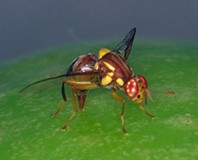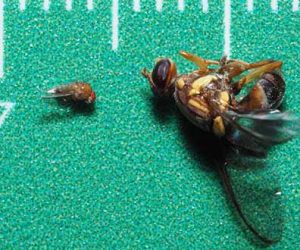Read the latest information on
Foot-and-mouth disease

Adult Qfly (shown here) are about 7 mm long and brownish in colour, with distinctive yellow markings. Females lay their eggs into soft and ripening host fruit. Larvae (maggots) inside the fruit are up to 10mm long.
Growers of fruit and vegetables that can be hosts of Mediterranean and Queensland fruit fly are reminded of the need to be vigilant when it comes to control of the pest year round.
Darryl Barbour, National Manager of the Fruit Fly Council, said it’s important to follow biosecurity rules and not give fruit flies a free ride interstate or into pest free areas.
“Vigilance must also extend to preparing consignments for domestic markets and when travelling interstate or between horticultural production areas,” said Darryl.
“Fruit flies only fly short distances, typically less than two kilometres. If they are found interstate it’s because they’ve somehow been given a free ride.”
“Recent fruit fly detections in South Australia and Tasmania highlight the importance of maintaining a focus on biosecurity.”
South Australian authorities are currently responding to fruit fly outbreaks in urban Adelaide, while Tasmanian authorities are dealing with outbreaks in Spreyton and on Flinders island – the first fruit flies trapped in the state since 2011.
As a result of these detections, a large area around Spreyton has been quarantined and movement of fruit prohibited unless a fruit fly treatment has been applied, which increases the costs for producers.
For example, Tasmanian growers, who are normally able to access mainland and overseas markets for their produce without costly controls, are now required to treat their products before export from the state. This unexpected requirement has closed markets for some growers who are unable to arrange treatments at short notice.

Vinegar fly (left) are smaller than Q-fly (right). Vinegar fly are about 2 mm long, have red eyes, hold their wings together along their back, and are found around fruit bowls and compost heaps. Image: Darryl Barbour
Investigations are still underway to determine how these fruit flies reached South Australia and Tasmania. The outbreaks are a timely reminder of the need for vigilance by growers and the public in controlling pests like fruit fly to ensure continued access to markets and a source of income.
Rod Turner, Chair of the Subcommittee on Domestic Quarantine and Market Access, said it’s Australia’s biosecurity system, including the actions of growers and the public, that allows producers to access premium markets around the world.
“To keep these markets open we need everyone to play their part, including growing, packing and certifying produce in line with the conditions for domestic trade,” said Rod.
“It also includes tourists, orchard workers and day trippers. It might take only a single infested fruit to cause a new outbreak,” he said.
Darryl Barbour agreed, adding: “Fruit flies are very good hitch-hikers, so it is important not to carry fruit interstate or to dispose of fruits in horticultural production areas.”
His advice to growers is that if you are in a fruit fly affected area, area wide management is the best weapon.
“Area wide management requires all producers, residents and local gardeners to do their bit to control fruit flies throughout the year,” said Darryl.
View a list of fruit and fruiting vegetables that host fruit fly
Fruit fly outbreaks in South Australia